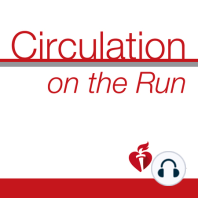17 min listen
Circulation June 5, 2018 Issue
ratings:
Length:
20 minutes
Released:
Jun 4, 2018
Format:
Podcast episode
Description
Dr Carolyn Lam: Welcome to Circulation on the Run, your weekly podcast summary and backstage pass to the journal and its editors. I'm Dr Carolyn Lam, associated editor from the National Heart Center and Duke National University of Singapore. This week's feature paper reports results of the SWAP-4 study, which is the first study to evaluate the pharmacodynamic impact of the timing and dosing of clopidogrel administration when de-escalating from ticagrelor therapy. Extremely important take-home messages for clinicians looking after patients with coronary artery disease and a must listen to. Coming up right after these summaries. In the first original paper this week, chondroitin sulfate, well known in the context of the monogenic disease mucopolysaccharidosis type 6 may actually represent a novel therapeutic approach for the treatment of general heart failure. First author Dr Zhao, corresponding author Dr Foo, from Genome Institute of Singapore studied changes in myocardial chondroitin sulfate in non-mucopolysaccharidosis failing hearts and assessed its generic role in pathological cardiac remodeling. They found that failing human hearts display an abundant accumulation of chondroitin sulfate proteoglycans in the extracellular matrix largely localized to fibrotic regions. The main component of chondroitin sulfate glycosaminoglycan chains in human hearts was chondroitin 4 sulfate. TNF alpha was a direct binding partner of glycosaminoglycan chains rich in chondroitin 4 sulfate. Modification of the chondroitin sulfate chain with the recombinant human arylsulfatase B, which is an FDA-approved treatment for mucopolysaccharidosis type 6 that targets chondroitin 4 sulfate, actually ended up reducing myocardial inflammation and overall fibrosis in vivo. In two independent rodent models of pathological cardiac remodeling, this recombinant human arylsulfatase B treatment prevented cardiac deterioration and improved functional recovery. Thus, targeting extracellular matrix chondroitin sulfate represents a novel therapeutic approach for the treatment of heart failure. The next paper focuses on the subcutaneous ICD, which is an entirely subcutaneous system that does not require intra-procedural vascular access or endovascular defibrillator leads or coils. Now the subcutaneous ICD has a novel mechanism of defibrillation and is associated with an increased energy requirement for defibrillation when compared to traditional transvenous ICDs. Thus, ventricular fibrillation or VF conversion testing at the time of subcutaneous ICD implantation is a class 1 recommendation. Yet, what is the current adherence to this recommendation? Well, today's paper addresses this question from first and corresponding author Dr. Friedman from Duke Clinical Research Institute. He and his co-authors studied first time subcutaneous ICD recipients between 2012 and 2016 in the National Cardiovascular Database Registry ICD Registry to determine the predictors of use of conversion testing, predictors of an insufficient safety margin during testing and in-hospital outcomes associated with the use of conversion testing. Results show that use versus non-use of VF conversion testing after subcutaneous ICD implantation in the US was more related to physician preference than patient characteristics. The study also identified several patient characteristics associated with an insufficient defibrillation safety margin. That included increased body mass index, severely decreased ejection fraction, white race, and ventricular pacing on the pre-implantation ECG. Use of VF conversion testing after subcutaneous ICD implantation was not associated with a composite of in hospital complications or death. These data may inform ICD sy
Released:
Jun 4, 2018
Format:
Podcast episode
Titles in the series (100)
Circulation January 24, 2017 Issue: Circulation Weekly: Your Weekly Summary & Backstage Pass To The Journal by Circulation on the Run
